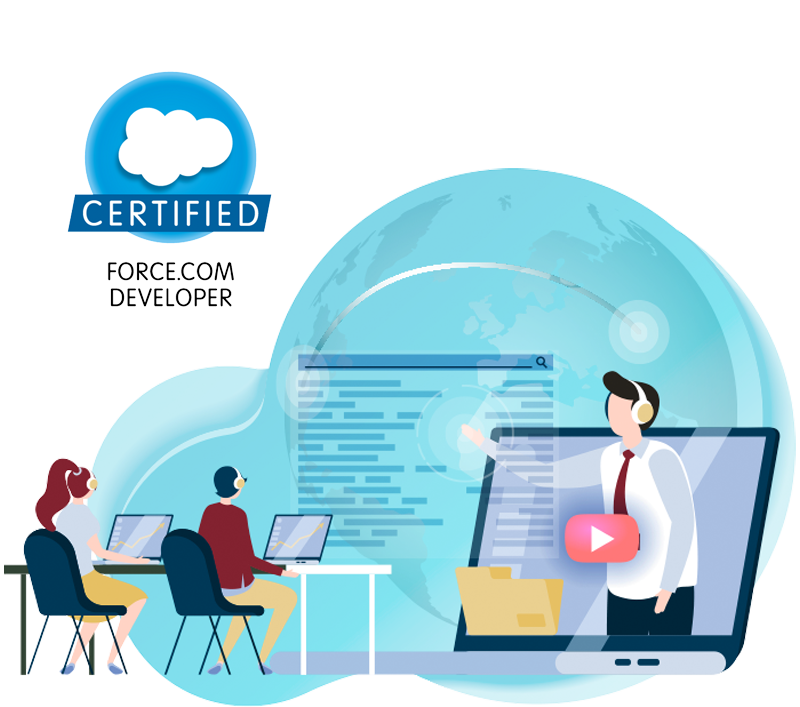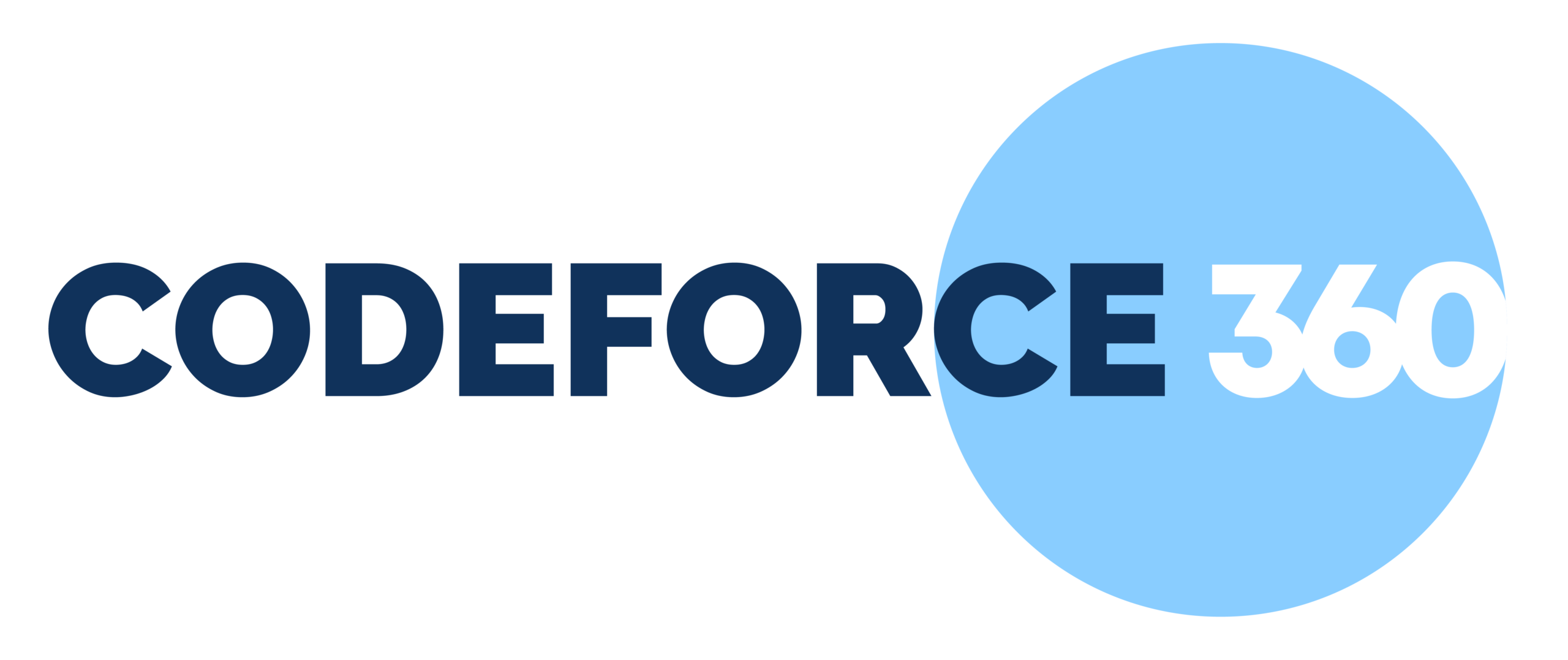Salesforce Development & Administration
Gain hands-on experience with this Salesforce certification training course while learning how to manage and develop apps for one of the most popular CRM platforms worldwide.

Fundamentals of Salesforce
- CRM basics and cloud computing
- com overview and foundation
- Salesforce platform, Salesforce terminology, and introduction to force.com platform
- Multi-tenancy and cloud
- Salesforce metadata and APIs
- Salesforce architecture
- The functionality of a central CRM object in Salesforce schema
- Determining declarative custom restrictions and programmatic custom use cases in a given scenario
- Declarative vs. Programmatic customizations
- Identify common scenarios for using the AppExchange extension organization
- OOP programming and database connections in Python
Its All About Data
Data Modeling and Management
- Identify appropriate data models in a given scenario
- Capabilities of different relationship types and the impact of each record access, reporting, and user interface.
- Identify considerations for changing the field type. Determine considerations and select the appropriate field type based on many requirements.
- Describe the features and considerations of the schema builder.
- Illustrate options and considerations for importing/exporting data.
- Describe the features and use cases of external objects under Salesforce.
- Trust, data model, field and relationship fields.
- Pattern generator, junction object, and business logic.
- Salesforce data management, data import wizard and data loader.
- Export data, Apex class variables, and methods.
- Class constructor, Apex, and access modifier.
- Apex development tools, development process, and governor boundaries.
Backing up and sharing data
- Describe the available features and ways to limit and extend objects, field access, and records
- Identify appropriate release solutions based on many business needs
- Salesforce application development tools
- Application development strategy using AppExchange
- Search and navigate Salesforce documents
Business logic & process automation
Describe the function and use case of:
- Record type
- Formula fields
- Of roll-up summary fields
- Validation rules
- Approval process
- Workflow, visual workflow and Lightning process builder
Working with Chatter
- Chatter features
- Chatter use cases
Analyze data using reports and dashboards
- Report type and dashboard
- Identify the features available when creating a report
Salesforce Development
- Describe development considerations in a multi-tenant environment
- System classes/methods, field API names, and standard objects.
- Relationships in Apex; basic SOQL syntax, functions, variable binding, keywords, relational queries, and SOQL-for-loops, SOQL Debugging with debug logs, and anonymous blocking.
- SOSL and SOSL
- Debugging tools
- Apex testing, testing classes, and unit testing
- System testing class methods
- Test classes, test data, unit testing using private variables and methods
Apex
Introduction to Apex Code
- Language constructs declaring variables & constants in Apex and assigning values using the various expressions
- Collection overview (lists, collections, and mappings), calling Apex, classes, interfaces, and objects
- Use and application of Apex control flow instructions
- Usage of basic SOSL, DML statements, and SOQL
- Apex design, dynamic and batch Apex
- Debug Apex, manage debug logs, and anonymous scripts
- Developer console, Force.com IDE, and workbench
- SaveResult classes, DML (Data Manipulation Language)
- DML & loop, DML options, Database, and transaction control
- SOQL and governor restrictions
- Apex triggers and execution order
- Trigger context variables; create and display triggers
- Recognize trigger events, helper class patterns, and batch triggers
- Handle recursion in triggers, using addError() and Apex trigger best practices to limit memory operations
- Exceptions, exception methods, and system-defined exceptions
- Handle user-defined or custom exception and intercept various exception types
Apex Triggers
- Governor limits, start/stop use, test Apex
- Bulkified code, test framework, create/load test data
- Use system.runAs to test configuration file security
Visualforce
- Describe how to write a Visualforce controller using JavaScript / HTML / CSS
- Use standard Visualforce controllers and custom Apex controllers/controller extensions
- Visualforce page, build method, development tool, tags, and their binding types & syntax
- Understand the MVC pattern
- Static resources in Visualforce
- Custom controllers;custom list controllers, methods, extensions, and execution order
- Salesforce Lightning overview
- Lightning component framework structure and its benefits
Salesforce Lightning
Salesforce Lightning
- Salesforce Lightning tools and technology collections
- Speed optimization of modern user interface speed optimization
- Salesforce Lightning experience and create reusable components to customize it
- Salesforce1 mobile application
Salesforce1 Lightning Process Builder
- Salesforce1 Introduction and its action layout
- Lightning process builder
- Use a visual layout to create a process and establish the entire process instead of using multiple workflow rules
- Collaborating for different users in the user interface
- Event-driven Lightning framework & Aura framework
- Deploy the domain using the developer console to create a lightning component
Use HTML and CSS styles
- Style Lightning components using HTML and CSS
- See the components in the Lightning App
- Use the developer console to create a CSS file
- Link to the lightning component and upload an external style sheet to a static resource
Attributes of Lightning component
- Typed fields for component instances
- Use expression syntax to reference from component tags
- Use attribute dynamic components
- Add attributes to a component or application using the aura:attribute> tag.
Lightning functions
- Client controller, functions, and Binding components
- Pass values and javascript based operationd
- Application attributes and reference components in the application
Component Composition
Learn to create:
- Simple components such as c:LC and c:LC2
- Fine-grained components in larger components by assembling each component
- Wrapper component with simple components.
Conditional Statements
Conditional If-else statement, isTrue expression, aura:if, component instantiating in its body or in the Else attribute
Use of Value Providers
Use value providers to access data, combine related values, component v (view) and c (control) value providers.
Out-of-the-box components
- Use out-of-the-box Salesforce1 components
- Lightning experience and its applications
- Different namespaces components, Force, Force Community, Aura, Force Chatter, etc.
- Style Lightning system, user interface, and namespace component
Generic UI & UI namespace
- Universal user interface, use of aura: components, UI components
- Handle common user interfaces and component extensions & designs
Dynamic update of UI components
- Dynamic update of UI components
- Trigger JavaScript controller actions for events in Lightning component
- Event declarations with aura:event tag
Handling events
- JavaScript and Java Swing for event-driven programming,
- Component and application events
- Write JavaScript controller actions handler
Server-side controller
- Create a server-side controller in Apex, Aura annotation
- Annotation that allow server-side and client access to controlled methods
- Invoke server-side controller operations from the client controller
Server-side controller hands-on
- A real-world example of fetching data from an opportunity object via server-side controller deployment
- Create the client controller to call the server-side controller and pass the returned value to the component
Create a Lightning application
- Create a contact management app on the Lightning Framework
- Upload CSS files and upload them to static resources for reference in the app
- Create a contact-controller Apex class
- Retrieve data from contacts and return to the contact list
- Design user interfaces using HTML & CSS classes provided in the style sheet (bootstrap)
Download our Full Course Packet
Test Form
Call us at
470-552-1720
Learn from the best
You will be trained, guided and mentored by highly skilled professionals who will teach you technology, industry best practices and “soft skills” that you need to be successful. You will work extensively on enterprise-level technologies and tools that are used by enterprises today.
Real World Experience
Using business processes and methodologies that are in use TODAY, we give you an experience of what it’s like to work in a real “Tech Team”
Ready to get started?
Apply to our program or schedule a meeting with your career advisor.
